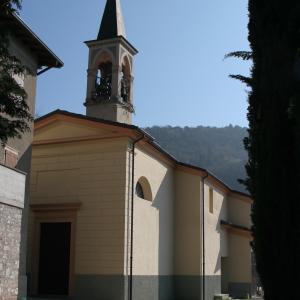In Sermerio it is possible to visit a small, simple church, dedicated to two Saints - San Bernardo Abate and San Martino Vescovo.
A church dedicated to two saints
The church of Sermerio was first dedicated to San Bernardo - in the past there there used to be a small chapel, dedicated to the saint, famous for being abbot of the beautiful Chiaravalle abbey just outside Milan.
The arrival of San Martino as co-patron saint dates back to around 700. The two saints had very different lives: the first led a mystical life, while the second participated actively in ecclesiastical life in Rome.
For a long time, the chapel was of secondary importance: the mass was in fact celebrated in Pieve di Tremosine sul Garda. In 1631, Mass began to be officially celebrated, and about fifty years later it was also allowed to celebrate all the other sacraments. The first official source that declares Sermerio parish in all respects dates back to 1854.
A rich and well-preserved church
The new church, as we know it today, dates back to the 16th century, when the building was very basic and not heavily decorated.
Inside, there are three altars - the main one is decorated with a painting portraying the two patron saints with the Virgin Mary.
Several artists from Brescia worked on the paintings and wooden details, then in 1700 a statue dedicated to San Bernardo was added, which was renovated in 2002.
The church is modest, but the inhabitants of the village made donations to maintain and modernize it constantly throughout history - at the end of the 17th century, it was they who built a vicarage and bought a bell for the belltower. It is currently one of the richest and best preserved churches in the municipality of Tremosine sul Garda.
Curious fact: the statue of Molina di Ledro
The history of the church of Sermerio is closely related with that of the small church of Molina di Ledro.
At the end of the First World War, when many Ledro Valley inhabitants were displaced in Bohemia, the parish priest of the village thought to bring the beautiful statue of the Madonna to safety, and move it to a more secure, controlled place.
Unfortunately he did not succeed, but some time later, an Italian soldier had the same concern and transferred it to the parish of Sermerio.





